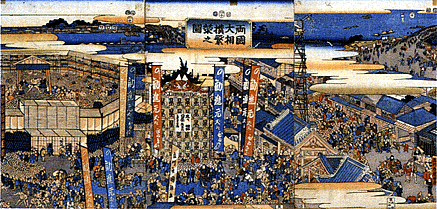 | |
|
The banners announce that this sumo tournament is a fund raiser (kanjin) for the temple that has provided the (legal) grounds to set up a dohyô (ring) for the event. The drum tower on the right signals the opening and closing of a day's matches. The "fund-raising" designation was a common way to circumvent city laws against conducting tournaments within city limits since religious institutions could petition the government to allow fund-raising events. It was clearly a profit-making operation for promoters. Official unease toward sumo seems to have stemmed from its popularity among commoers. A decree in 1711 read:
Like many such popular entertainments in Edo Japan, it didn't come to an end. Rather, its fandom only grew. Popular wrestlers--just like today--reached idol status and cut impressive figures on woodblock prints which, like those of Kabuki actors and famous courtesans, sold like hot (rice) cakes. For a ringside seat, click on the dohyô. Click the drum tower to see what it looks like today. | |
|
|